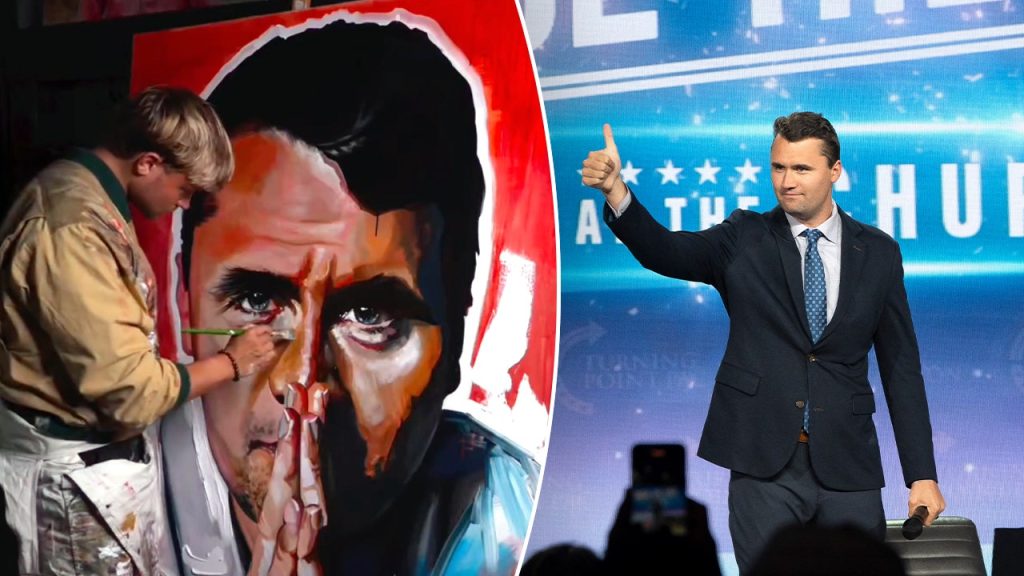Mississippi Artist’s Tribute to Charlie Kirk Goes Viral Amid Controversy and Support
In the wake of Charlie Kirk’s tragic assassination at Utah Valley University on September 10, a Mississippi artist’s tribute has captured the hearts of millions while also drawing significant backlash. Samuel Ingram, known professionally as Sam Ryan, created a powerful portrait of Kirk in a posture of prayer or reflection, using patriotic colors of red, white, blue, and black. The painting, completed in a single 12-hour overnight session and released on September 11, depicts Kirk with hands pressed together before his face, conveying a serious, contemplative expression. This heartfelt memorial piece was prominently featured during Kirk’s memorial service, which was viewed by millions across the country. What makes the tribute particularly poignant is the personal connection between the artist and Kirk—the Turning Point USA founder had previously reached out to Ryan after seeing his viral painting of President Trump following the July 2024 assassination attempt, expressing interest in purchasing a print.
The aftermath of sharing the Kirk portrait revealed the deep political divisions in American society. Ryan disclosed to Fox News Digital that he lost over 100,000 followers across his social media platforms, including 44,000 on Instagram alone. Even more disturbing, he continues to receive death threats more than a month after Kirk’s passing. “All for painting somebody I had a personal connection with,” Ryan explained. “It wasn’t really a political statement, even though I am conservative. It was more of a personal sentiment for his family and something God’s given me the ability to do—to paint and do portraiture in the style that I do that attracts attention somehow.” Despite the negative reactions, Ryan emphasized that Kirk was a human being who “didn’t deserve” what happened to him, adding that in his view, Kirk “never said anything that was downright wrong” or hateful, contrary to criticisms circulating online.
The backlash, however, has been counterbalanced by an overwhelming surge of support. Ryan gained over a million new followers across his platforms, with “a couple hundred thousand per platform.” This groundswell of support from conservative and Christian audiences has transformed what began as a personal tribute into something far more significant for the artist’s career. Ryan even traveled from Mississippi to Arizona to attend Kirk’s memorial service on September 21, describing the experience as bittersweet—a career milestone occurring under the most tragic of circumstances. The painting itself will find a permanent home at Turning Point USA headquarters, and due to enormous interest, Ryan plans to sell a limited number of personally signed prints through his website from October 17-19, with approximately 20,000 people already on the waitlist.
Ryan’s interpretation of Kirk’s death reveals the depth of his faith and worldview. The artist compared Kirk’s assassination to the crucifixion of Jesus Christ, suggesting that both faced persecution for speaking truth. “A lot of the time, people don’t want to hear the truth—they want to be comforted,” Ryan reflected. “I think he shook a lot of demons that are hiding in the world out there, and they took him out because of that.” Drawing further biblical parallels, Ryan noted, “Jesus, it only took 12 [disciples] for Him to spread the message—and Charlie had a lot more than 12 getting the word out. When you get all those eyeballs on you, there are a lot of crazy people in the audience that just hate you for spreading the message of the gospels.”
The story of Ryan’s painting illuminates the intense polarization in American society, where even an artistic tribute to a controversial figure can become a lightning rod for both adoration and hatred. What Ryan describes as a heartfelt memorial, others have interpreted as political endorsement. This division extends beyond social media reactions to the broader public response to Kirk’s death, which has included both massive memorial services and critical commentary about his political legacy. The portrait itself, with its imagery of prayer and contemplation, seems designed to emphasize Kirk’s faith rather than his politics—though for many Americans, the two have become increasingly intertwined. Ryan’s experience demonstrates how art centered on political figures cannot escape being interpreted through ideological lenses, regardless of the artist’s stated intentions.
Ultimately, Ryan frames his artistic mission in spiritual terms, hoping that his work might inspire others toward faith and goodness. “Anything that makes people feel something is what inspires me, and I hope to just spread the good in the world and block out the bad,” he explained. The story of his Kirk portrait encapsulates the complex intersection of art, faith, politics, and human tragedy in contemporary America. What began as one artist’s personal tribute to someone he briefly connected with has expanded into something much larger—a touchstone for discussions about political violence, artistic expression, and the power of visual imagery to evoke strong emotional responses. As the painting finds its permanent home at Turning Point USA and limited editions make their way to thousands of supporters, Ryan’s tribute to Kirk will continue to serve as both memorial and lightning rod, a reflection of America’s deep divisions and the enduring power of art to speak into troubled times.















